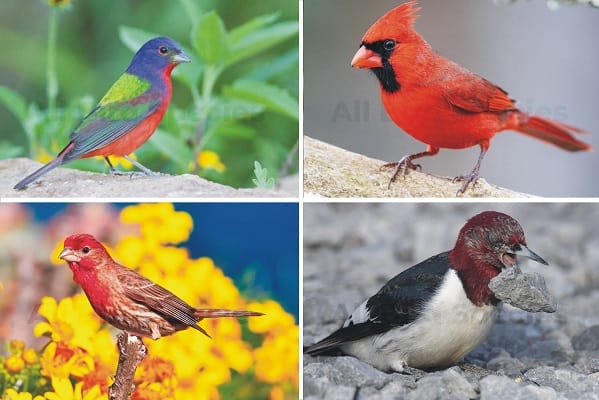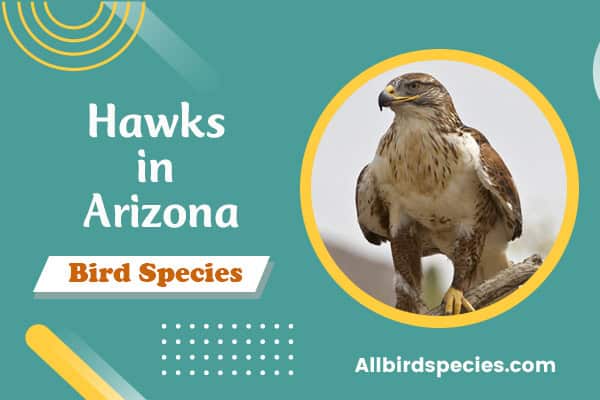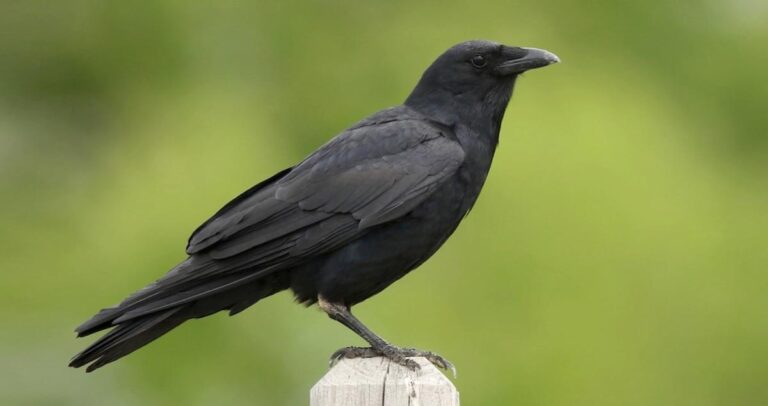8 Types of Red Birds in Florida With Pictures (ID Guide)
Did you know Florida has 12 “red” birds of species? These birds make the state’s landscapes more vibrant. They also make birdwatching more fun. This guide will show you eight red birds found in Florida, with pictures and details to help you identify them.
Exploring this guide, you’ll learn about their unique traits, behaviours, and where they live. It’s great for both new and experienced birdwatchers. You’ll get to know birds like the Northern Cardinal and the Scarlet Tanager. They add beauty to Florida’s outdoors.
Introduction to Red Birds in Florida
Florida is a birdwatcher’s dream, especially for those who love red birds. These birds are not just beautiful; they are also key to the local ecosystem. The Northern Cardinal, Florida’s state bird, is known for its beautiful songs and smart mimicry. The Florida Scrub-Jay is unique to the state, making it a must-see for birdwatchers.
Red birds like Roseate Spoonbills and Scarlet Tanagers add to Florida’s rich wildlife. Roseate Spoonbills are known for their bright pink feathers and unique bills. These help them find food in wetlands. Birdwatchers often visit these areas to see these birds, showing the variety of wildlife in Florida.
When you explore Florida, watch for migratory birds. In spring, their bright red feathers add to the beauty of birdwatching. Learning about these birds helps you appreciate Florida’s natural beauty and its bird life even more.
Characteristics of Red Birds
Red birds stand out with their bright looks and actions. Their colorful feathers show they are healthy and ready to mate. Watching these birds closely will make birdwatching more fun.
Common Features of Red Birds
Red birds are known for their bright colors. For example, the male Northern Cardinal is easy to spot with its bright red. This color attracts many people as it moves through Florida’s areas.
Male cardinals have stunning feathers, while females have red touches on their grey-brown feathers. These colors help them attract mates and show their health.
Behavioral Traits
Knowing how birds act helps us identify them better. Cardinals are interesting to watch because they visit feeders for seeds. They show off their bright colors while doing this.
Male cardinals are very protective of their territory. They fight hard to keep it safe, even when they see their own reflection in windows. Seeing these behaviors teaches us more about these birds and makes us appreciate them more.
1. Northern Cardinal
- Scientific Name: Cardinalis cardinalis
- Size: 21–23 cm (8.3–9.1 in)
- Weight: 38–65 g (1.3–2.3 oz)
- Lifespan: Up to 15 years in the wild
- Diet: Seeds, fruits, and insects
The Northern Cardinal is a standout red bird in Florida. Males are bright red, while females are pale brown with reddish tints. Knowing the difference between males and females helps with bird ID. Males are easy to spot with their red color, short bill, and tall crest.
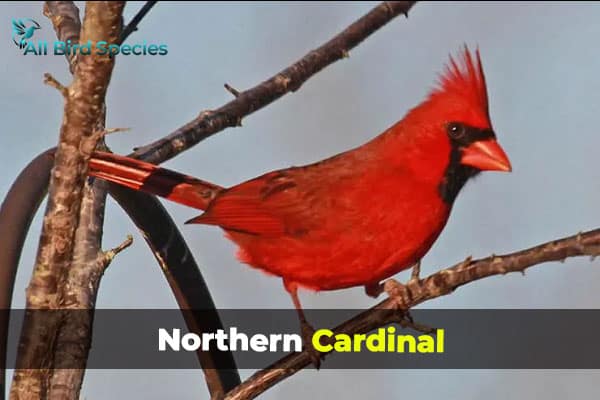
Identifying Features
Both males and females have unique traits like loud whistles. Young birds have gray to black bills, unlike adults. Adults use their strong bills to get seeds. Males are a bit smaller than American Robins and like suburban areas.
They perch high when singing, making them easy to see in gardens and parks.
Habitat and Feeding Preferences
Northern Cardinals live in many places, like backyards and parks. Also, They like bird feeders and eat seeds, fruits, and insects. They search for food on the ground, in trees, and shrubs.
They nest in dense foliage, showing they value privacy and safety during breeding.
2. House Finch
- Scientific Name: Haemorhous mexicanus
- Size: 14–18 cm (5.5–7 in)
- Weight: 16–32 g (0.56–1.13 oz)
- Lifespan: Up to 11 years in the wild
- Diet: Seeds, fruits, and plant matter
The House Finch is a bird known for its easy-to-spot traits and social ways. Males have a bright, rosy red head and upper breast. This looks nice against the brown streaks on their body. Females have streaked brown feathers that are less bright.

These birds have a notched tail and a conical bill. This helps them crack seeds well.
Physical Characteristics
House Finches are small, about 5 to 6 inches long. They are agile, with short wings and a tail for quick moves. Males get their red color from their diet during molting.
This color helps a lot in telling them apart.
Behavior and Social Structure
House Finches are very social, often seen in small groups. This helps them survive in cities. They like to visit feeders, showing their curiosity.
They eat seeds, fruits, grains, flowers, and buds. This shows they can adapt to many foods. House Finches feed their young only plant foods, which is rare.
They interact with other birds, showing they are smart and strategic. They are common in 31 Florida counties and have thrived in northern Florida for over a decade.
Watching these finches, you’ll see their bright colors and lively actions are why bird watchers love them. They have spread across almost all of the eastern United States and southern Canada in 50 years. The oldest House Finch lived at least 11 years and 7 months, showing they can live a long time.
3. American Robin
- Scientific Name: Turdus migratorius
- Size: 23–28 cm (9–11 in)
- Weight: 70–100 g (2.5–3.5 oz)
- Lifespan: Up to 6 years in the wild
- Diet: Primarily insects, berries, and fruits
The American Robin is a well-known bird in Florida. It has a bright rusty red breast and sings a happy song. To spot this bird, look for a few key features.
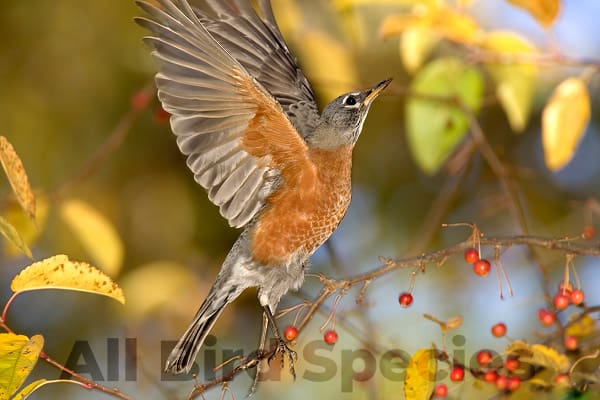
These include a rounded body, a yellow bill, and a dark head. These traits make the American Robin easy to identify.
Identification Tips
To identify an American Robin, watch for its physical traits and actions:
- Look for their bright red-orange breast against grey feathers.
- They often hop on the ground.
- Listen for their clear, morning songs.
Florida is home to over 550 bird species. This makes birdwatching exciting, with many species to see. In St. Petersburg, over 1.45 million robins were found in one winter roost.
Diet and Feeding Habits
The American Robin eats invertebrates and fruits. In spring and summer, they hunt worms and insects in lawns and gardens. Their feeding habits include:
- They actively search for food in the soil.
- They also eat fruits like berries, helping control insects.
In Florida, robins are known for living together. They don’t build nests or raise young here. They come for the warmer weather. Watching them forage helps us understand their diet and our ecosystems.
| Feature | Description |
|---|---|
| Coloration | Rusty red breast, grey-brown back and head |
| Size | Approximately 9-11 inches long |
| Call | Cheerful melodic voice |
| Diet | Invertebrates, fruits |
| Feeding Behavior | Foraging primarily on the ground |
In summary, the American Robin is a standout bird in Florida. It has unique features and a special diet. It plays a key role in the local ecosystem.
4. Scarlet Tanager
- Scientific Name: Piranga olivacea
- Size: 18–20 cm (7–8 in)
- Weight: 24–30 g (0.8–1.1 oz)
- Lifespan: Up to 13 years in the wild
- Diet: Primarily insects and fruits
The Scarlet Tanager is a beautiful bird known for its bright colors and lovely songs. Adult males have bright red feathers with black wings and tails. Females and young birds have olive-yellow feathers with darker wings and tails. Their songs are clear and whistled, with males singing louder and longer than females.
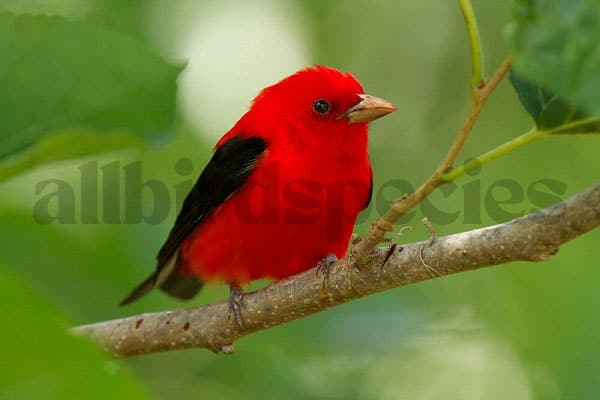
Appearance and Songs
Scarlet Tanagers are medium-sized, between the Northern Cardinal and Yellow Warbler. Their songs are a joy to hear, helping birdwatchers spot them in dense forests. The males’ bright colours make them popular in bird photography and watching.
Preferred Habitat
Scarlet Tanagers live in deciduous and mixed forests in eastern North America. They love large, untouched forests for food and nesting. They also nest in small forest patches, especially in the Northeast. During breeding, they host Brown-headed Cowbird eggs, showing their adaptability to their surroundings.
8 Types of Red Birds in Florida
Florida is a paradise for bird lovers, with many red birds to see. This guide lists eight red birds found in the state. It includes their special features and where to find them. It’s perfect for birdwatchers wanting to see these colourful birds.
- Northern Cardinal: This bird is common in Florida backyards. Males are bright red, and females are greyish. They often visit bird feeders in big groups.
- House Finch: House Finches are seen at bird feeders. They come in groups of about 2.5.
- American Robin: Known for its reddish-orange breast, this bird is found in parks and gardens.
- Scarlet Tanager: Rare but stunning, this bird has a bright red body and black wings. It’s found in forests during migration.
- Mourning Dove: Not all red, but it has a soft pinkish color. It’s about twelve inches long and lives in cities.
- Blue Jay: Mostly blue, but it can have red in its feathers. Blue Jays are smart and interesting to watch.
- Northern Mockingbird: Mostly gray, but males can have red. Their songs are beautiful and loved by birdwatchers.
- Eastern Bluebird: This bird is colorful, with males being more blue. It’s a favorite among bird lovers for its beauty.
These colorful birds live in different places in Florida. Seeing them makes birdwatching more fun and helps us appreciate nature.
Florida’s red birds are amazing to watch. Bird lovers can learn about their habits and help protect these special birds.
By November 2022, Florida had 539 bird species, making it great for birdwatchers. The variety of birds in Florida makes it exciting for nature fans to explore.
Birdwatching in Florida
Birdwatching in Florida is a special experience. It combines the excitement of seeing different birds with the calm of nature. The state has 29 National Wildlife Refuges and 11 National Parks, making it great for bird lovers. You can find amazing places like Everglades National Park and Corkscrew Swamp Sanctuary, covering 10,500 acres.
The best time to go birdwatching is early morning or late afternoon. Birds are most active then. Don’t forget to bring binoculars, a field guide, and comfy clothes. A notebook is useful for notes on what you see and do.
State parks and coastal areas offer great birdwatching spots. Merritt Island National Wildlife Refuge, near the Kennedy Space Center, is home to many species. Joining local birdwatching groups can also help. They share tips on where to find birds and what to look for.
| Birding Locations | Acreage |
|---|---|
| Everglades National Park | Largest wilderness area in the eastern US |
| Corkscrew Swamp Sanctuary | 10,500 acres |
| J.N. “Ding” Darling National Wildlife Refuge | 6,400 acres |
| Big Cypress National Preserve | 729,000 acres |
| Myakka River State Park | 37,000 acres |
| Oscar Scherer State Park | 1,381 acres |
Florida is a great place for birdwatching, whether you’re new or experienced. The Great Florida Birding & Wildlife Trail covers 2,000 miles. It links 492 birding spots, offering endless chances to learn and explore.
Read More🐦Related Articles:
| Doves in Illinois |
| White Birds in Hawaii |
| Small Birds With Long Necks |
| Hummingbirds In Kansas |
| Doves (Pigeons) That Live in Kansas |
Conclusion
Seeing the bright red birds in Florida is a joy. It shows us how rich and diverse the state’s wildlife is. Birds like the Northern Cardinal, Rose-breasted Grosbeak, and Scarlet Tanager teach us about local ecosystems.
They remind us of the balance in nature. Birdwatching lets us connect with nature. It helps us see how species and their homes work together.
When you see a red bird, think about helping to save them. Every little bit helps protect these birds and their homes for the future. Let’s work together to keep Florida’s wildlife beautiful.

